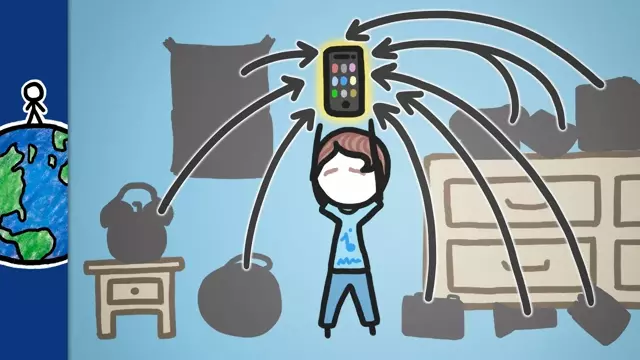2019-11-25
[public] 170K views, 9.5K likes, dislikes audio only
Thanks to the University of Minnesota for sponsoring this video! http://twin-cities.umn.edu/
MinuteEarth and the University of Minnesota are not affiliated with Apple Inc. or any other smartphone manufacturers and do not endorse any of the products mentioned in this video.
The way smartphones made many devices nonessential is a model for a new way to think about improving energy efficiency.
Thanks also to our Patreon patrons https://www.patreon.com/MinuteEarth and our YouTube members.
___________________________________________
To learn more, start your googling with these keywords:
Dematerialization - using less (or no) material to deliver the same service
Energy conservation - using less energy by adjusting behavior (turning down your heat)
Energy efficiency - using less energy by using technology that requires less energy to perform the same function (insulating your house to keep warm while using less energy)
Energy intensity - energy consumption per unit of GDP (reduced by increasing energy efficiency)
Energy services - the useful functions you're able to perform by using energy (what we refer to as ‘function’)
___________________________________________
If you liked this week’s video, you might also like:
Phones are great for the environment https://www.wired.com/story/iphone-environment-consumption/
Nope, phones are bad for the environment https://theconversation.com/how-smartphones-are-heating-up-the-planet-92793
Amory Lovins on ‘integrative design’ (watch the video abstract) - https://iopscience.iop.org/article/10.1088/1748-9326/aad965/meta
The US would use 85% more energy if it weren’t for efficiency efforts since the 1970s https://thehill.com/blogs/congress-blog/energy-environment/308170-cheap-clean-and-easily-accessible-an-energy-resource
US energy intensity has halved since 1970 https://www.eia.gov/todayinenergy/detail.php?id=10191
This chart shows just how much energy the US is wasting https://www.weforum.org/agenda/2018/05/visualizing-u-s-energy-consumption-in-one-chart
_________________________________________
Subscribe to MinuteEarth on YouTube: http://goo.gl/EpIDGd
Support us on Patreon: https://goo.gl/ZVgLQZ
And visit our website: https://www.minuteearth.com/
Say hello on Facebook: http://goo.gl/FpAvo6
And Twitter: http://goo.gl/Y1aWVC
And download our videos on itunes: https://goo.gl/sfwS6n
___________________________________________
Credits (and Twitter handles):
Script Writer, Editor and Video Narrator: Alex Reich (@alexhreich)
Video Illustrator: Sarah Berman (@sarahjberman)
Video Director: David Goldenberg (@dgoldenberg)
With Contributions From: Henry Reich, Kate Yoshida, Ever Salazar, Peter Reich, Julián Gómez, Arcadi Garcia
Music by: Nathaniel Schroeder: http://www.soundcloud.com/drschroeder
___________________________________________
References:
Belkhir, L., & Elmeligi, A. 2018. Assessing ICT global emissions footprint: Trends to 2040 & recommendations. Journal of Cleaner Production, 177, 448-463. https://doi.org/10.1016/j.jclepro.2017.12.239
Bento, N. 2016. Calling for change? Innovation, diffusion, and the energy impacts of global mobile telephony. Energy Research & Social Science, 21, 84-100. https://repositorio.iscte-iul.pt/bitstream/10071/12732/5/Accepted_manuscript_Jun16.pdf
Cullen, J. M., Allwood, J. M., & Borgstein, E. H. 2011. Reducing energy demand: what are the practical limits?. Environmental science & technology, 45(4), 1711-1718. dx.doi.org/10.1021/es102641n
Fell, M. J. 2017. Energy services: A conceptual review. Energy research & social science, 27, 129-140. https://doi.org/10.1016/j.erss.2017.02.010
Grubler, A., et al. 2018. A low energy demand scenario for meeting the 1.5 C target and sustainable development goals without negative emission technologies. Nature Energy, 3(6), 515. https://doi.org/10.1038/s41560-018-0172-6
Lovins, A. B. 2018. How big is the energy efficiency resource?. Environmental Research Letters, 13(9), 090401. https://iopscience.iop.org/article/10.1088/1748-9326/aad965/meta
Popovich, N. March 8, 2019. America’s Light Bulb Revolution. https://www.nytimes.com/interactive/2019/03/08/climate/light-bulb-efficiency.html
Suckling, J., & Lee, J. 2015. Redefining scope: the true environmental impact of smartphones?. The International Journal of Life Cycle Assessment, 20(8), 1181-1196. https://doi.org/10.1007/s11367-015-0909-4
Visitor’s Guide. August 2007. Rocky Mountain Institute. https://d231jw5ce53gcq.cloudfront.net/wp-content/uploads/2017/04/Locations_LovinsHome_Visitors_Guide_2007.pdf
https://www.patreon.com/minuteearth
/youtube/channel/UCeiYXex_fwgYDonaTcSIk6w
https://patreon.com/minuteearth
/youtube/video/4DF94Wvtekk

